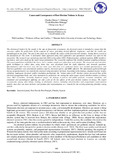Causes and Consequences of Post-Election Violence in Kenya
Date
2023-10-05Author
Ochieng, Charles Otieno P.
Matanga, Frank Khachina
Iteyo, Chrispinous
Metadata
Show full item recordAbstract
The election of leaders by the people is the aim of democratic procedures. An electoral system is intended to ensure that the outcomes reflect the preferences of the majority of voters, providing elected officials’ legitimacy, and that the results are unchallenged in any form. The aim of this study was to identify the causes of the post-election violence. Voting theory served as the foundation for this work. A descriptive study approach using both qualitative and quantitative methods was used by the researcher. The research was carried out from July 2022 to December 2022. Political parties, political analysts, IEBC members, legislators, and voters made up the study's target population. The researcher employed the stratified random sampling technique. The target population established the strata, and a random sample was taken from each stratum. The researcher used interview guide techniques to collect data, using items that were developed from the study objectives and research questions. Questionnaires and interviews were the two main ways that data were gathered. Voters were handed questionnaires, and interview guidelines were provided for political experts, electoral experts, and IEBC officials. The information gathered through the use of questionnaires was statistically analyzed using descriptive methods. According to the findings, disputed election results, tribalism, inadequate electoral conflict resolution mechanisms, the "winner-takes-it-all" election system, perceived bias of the electoral management body, and voter incitement by politicians are among the main causes of post-election violence in Kenya since 1963. Casualties, internally displaced people, the damage to private and public property, economic instability, and emotional and psychological suffering are only a few of the key effects of the post-election violence in Kenya. The report recommends, among other things, looking at alternative choices, including mixed-member and proportional representation models, since they are more inclusive and produce fair representation, as a remedy for the existing polarizing plurality voting system.
URI
https://doi.org/10.51867/ajernet.4.2.50https://ajernet.net/ojs/index.php/ajernet/article/view/138
http://ir-library.mmust.ac.ke:8080/xmlui/handle/123456789/2386
Collections
- Gold Collection [969]

